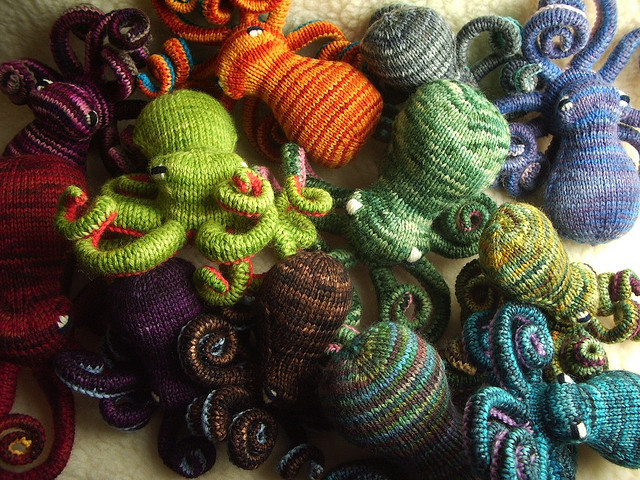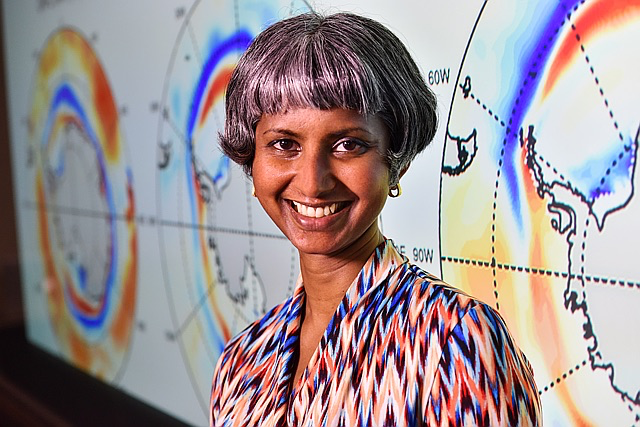Outreach
Activism through the Arts
Today, human actions are having a substantial impact on the environment. Nowhere is this more evident than in the world’s oceans, where acidification (due to human-induced climate change), over-fishing, and plastic pollution are threatening marine ecosystems. The science is clear that human actions are harming the oceans; however, collective action to mitigate these harms is not yet sufficient to reverse them.
In November 2018, I participated in All Hands on Deck, an event bringing together artists, activists, scientists, entrepreneurs, actors, filmmakers, legal experts, and other ocean connoisseurs, all with a passion to increase societal engagement with the ocean, and with it, the collective will to take action on issues endangering the marine world.
Touching others through the arts is one way to inspire such awareness and action. For several years, one of my passions was knitting the ocean. A complete portfolio of my work is available here.


I spoke about this passion at All Hands on Deck, and, generally, how the arts can connect humans to the environment and inspire action in ways that science itself cannot. You can check out the talk here.
K-12 Outreach
As a graduate student at the Department of Atmospheric Sciences at the University of Washington, I participated in the Atmospheric Sciences Outreach group, a student-led initiative to bring exciting hands-on demonstrations about weather, climate, and mathematics to Seattle-area elementary, middle, and high schools.
My (amazing) friend and colleague Judy Twedt and I extended the work of the Outreach group in a couple of ways. First, we designed a simple, portable demonstration of the greenhouse effect, namely the trapping of infrared radiation without trapping radiation from the visible part of the spectrum, using a portable IR camera that can be plugged into a smartphone. The activity is similar to the (much less portable) greenhouse effect demonstration performed by Dr. Iain Stewart for the BBC. Our demonstration is now a staple of the Atmospheric Sciences Outreach group, and has been used to educate hundreds of students about the greenhouse effect and climate change.
Another one of my contributions to outreach, also in collaboration with colleague Judy Twedt, was to design a computational module for the study of climate science optimized for use by high school students. The module provides an under-the-hood introduction to scientific computing with Python, which is increasingly becoming the preferred coding language for data analysis in the Earth Sciences, with the most basic physics of planetary energy balance through the Budyko-Sellers model. We presented this module yearly at the Expanding Your Horizons conference, a series of workshops for high school girls to encourage their interest in STEM (Science, Technology, Engineering, and Mathematics) fields.
I look forward to continuing educational outreach efforts in my new home city of Victoria, British Columbia. Stay tuned!
Understanding Climate Change
The Earth’s climate is changing. Human activities, particularly the burning of fossil fuels and the associated greenhouse gas emissions that are increasing the infrared absorptivity of the atmosphere, are (at least) partly to blame. Here are some of my favorite resources for understanding the earth system, climate, and climate change.
- RealClimate: a blog written by climate scientists describing the latest scientific findings in climate research and related policy developments
- Skeptical Science: a blog devoted to explaining the science of climate and climate change. Their Most Used Climate Myths and What the Science Really Says is an excellent resource for combatting climate change denialism.
- NASA Earth Observatory: a beautiful view (and scientific explication) of the Earth from space, updated daily
- Earth: an interactive, addictive visualization of the current state of the Earth’s meteorological variables, including temperature, winds, precipitable water, and a bunch more (click on the icon in the lower left-hand corner to bring up the menu; note that not all variables are directly observed, but may rather be indirectly inferred from other observed variables)
- IPCC AR5 Summary for Policymakers: the summary for policymakers from the 5th assessment report by the Intergovernmental Panel on Climate Change (IPCC). The new IPCC AR6 will be on its way in the next year, so stay tuned!


